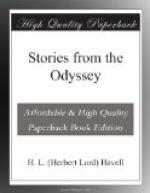ODYSSEUS AND PENELOPE
CONCLUSION
PRONOUNCING LIST OF NAMES
ILLUSTRATIONS
READING FROM HOMER (L. Alma Tadema)
Penelope (The Vatican, Rome)
Telemachus departing from Nestor (Henry Howard)
Odysseus and NAUSICAAe (Charles Gleyre)
Odysseus and Polyphemus (J. M. W. Turner)
Circe (Sir E. Burne-Jones)
The return of Odysseus (L. F. Schuetzenberger)
Odysseus and Eurycleia (Christian G. Heyne)
INTRODUCTION
The impersonal character of the Homeric poems has left us entirely in the dark as to the birthplace, the history, and the date, of their author. So complete is the darkness which surrounds the name of Homer that his very existence has been disputed, and his works have been declared to be an ingenious compilation, drawn from the productions of a multitude of singers. It is not my intention here to enter into the endless and barren controversy which has raged round this question. It will be more to the purpose to try and form some general idea of the characteristics of the Greek Epic; and to do this it is necessary to give a brief review of the political and social conditions in which it was produced.
I
The world as known to Homer is a mere fragment of territory, including a good part of the mainland of Greece, with the islands and coast districts of the AEgaean. Outside of these limits his knowledge of geography is narrow indeed. He has heard of Sicily, which he speaks of under the name of Thrinacia; and he speaks once of Libya, or the north coast of Africa, as a district famous for its breed of sheep. There is one vague reference to the vast Scythian or Tartar race (called by Homer Thracians), who live on the milk of mares; and he mentions a copper-coloured people, the “Red-faces,” who dwell far remote in the east and west. The Nile is mentioned, under the name of AEgyptus; and the Egyptians are celebrated by the poet as a people skilled in medicine, a statement which is repeated by Herodotus. The Phoenicians appear several times in the Odyssey, and we hear once or twice of the Sidonians, as skilled workers in metal. As soon as we pass these boundaries, we enter at once into the region of fairyland.
II
In speaking of the religion of the Homeric Greeks we have to draw a distinction between the Iliad and the Odyssey. In the Iliad the gods play a much livelier and more human part than in the latter poem, and it is highly remarkable that the only comic scenes in the first and greatest of epics are those in which the gods are the chief actors—as when the lame Hephaestus takes upon him the office of cupbearer at the Olympian banquet, or when Artemis gets her ears boxed by the angry Hera. It would almost seem as if there were a vein of deliberate satire running through these descriptions, so daring is the treatment of the divine personages.




